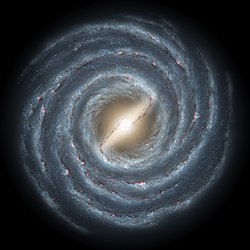Triangulum II
| Galaxie Triangulum II | |
|---|---|
| Triangulum 2 | |
| AladinLite | |
| Sternbild | Dreieck |
| Position Äquinoktium: J2000.0, Epoche: J2000.0 | |
| Rektaszension | 02h 13m 17,4s[1] |
| Deklination | 36° 10′ 42,4″[1] |
| Erscheinungsbild | |
| Morphologischer Typ | UFD[2] |
| Winkelausdehnung | (3.9+1.1−0.9)'[1] |
| Physikalische Daten | |
| Zugehörigkeit | Lokale Gruppe |
| Radialgeschwindigkeit | (−382.1 ± 2.9) km/s[3] |
| Entfernung | (97.800 ± 6.500) Lj / (30.000 ± 2.000) pc [1] |
| Absolute Helligkeit | (−1.8 ± 0.5) mag[1] |
| Metallizität [Fe/H] | −2.50 ± 0.08[3] |
| Geschichte | |
| Entdeckungsdatum | 2015 |
| Katalogbezeichnungen | |
Triangulum II (Tri II oder Laevens 2) ist eine äußerst lichtschwache, sphäroide Zwerggalaxie. Sie wurde im Jahr 2015 von Benjamin P. M. Laevens et al. am Keck-Observatorium entdeckt. Nach den astrometrischen Messungen von Gaia (ESA, 2018) umkreist Tri II die Milchstraße am Rand des äußeren Halos[4] auf einer nahezu kreisförmigen Bahn im heliozentrischen Abstand von 30.000 Parsec.[5] Vorangehende Messungen hatten überwiegend eine geringere Entfernung ausgewiesen.[3] Der Halblichtradius wird mit 34+9−8 pc angegeben. Das Alter wird auf etwa 13 Milliarden Jahre abgeschätzt.[1]
Die Zwerggalaxie Tri II umfasst ca. 1000 Sterne und hat eine Leuchtkraft von nur 450 L☉.[3][5] Triangulum II entspricht der Definition einer „Galaxie“.[6] Dies steht auch in Einklang mit der geringen Häufigkeit von Neutroneneinfang-Elementen.[2] Bemerkenswert ist außerdem das sehr hohe Masse-Leuchtkraft-Verhältnis von 3600+3500−2100 M☉/L☉; dies macht sie zu einer der am stärksten von Dunkler Materie dominierten Galaxien.[3]
Obwohl durch die Milchstraße deutlich wirksame Gezeitenkräfte ausgeübt werden, befindet sich Tri II im dynamischen Gleichgewicht. Angesichts der relativ geringen Anzahl der Sterne ist dieser physikalische Zusammenhalt nicht selbstverständlich.[3]
Auch detaillierte Messungen von den Geschwindigkeitsverteilungen der Sterne innerhalb der Zwerggalaxie legen nahe, dass Triangulum II einen äußerst hohen Anteil an Dunkler Materie aufweist. Nach aktuellen Einschätzungen von Astronomen ist Triangulum II ein wichtiger Kandidat zum experimentellen Nachweis Dunkler Materie.[7]
Einzelnachweise
- ↑ a b c d e Benjamin P. M. Laevens, Nicolas F. Martin, Rodrigo A. Ibata, Hans-Walter Rix, Edouard J. Bernard, Eric F. Bell, Branimir Sesar, Annette M. N. Ferguson, Edward F. Schlafly, Colin T. Slater et al.: A New Faint Milky Way Satellite Discovered in the PAN-STARRS1 3π Survey. In: The Astrophysical Journal. Band 802, Nr. 2, 31. März 2015, S. L18, doi:10.1088/2041-8205/802/2/L18, arxiv:1503.05554, bibcode:2015ApJ...802L..18L.
- ↑ a b Alexander P. Ji, Joshua D. Simon, Anna Frebel, Kim A. Venn, and Terese T. Hansen: Chemical Abundances in the Ultra-faint Dwarf Galaxies Grus I and Triangulum II: Neutron-capture Elements as a Defining Feature of the Faintest Dwarfs. In: The Astrophysical Journal. Band 870, Nr. 2, 11. Januar 2019, S. 83, doi:10.3847/1538-4357/aaf3bb, bibcode:2019ApJ...870...83J.
- ↑ a b c d e f Evan N. Kirby, Judith G. Cohen, Joshua D. Simon, Puragra Guhathakurta: Triangulum II: Possibly a Very Dense Ultra-faint Dwarf Galaxy. In: ApJL. Band 814, Nr. 1, November 2015, ISSN 0004-637X, S. L7, doi:10.1088/2041-8205/814/1/L7 (harvard.edu [abgerufen am 14. Juni 2020]).
- ↑ Daniel Fischer: Der Halo der Milchstraße besteht aus zwei Komponenten. In: Abenteuer Astronomie. 4. Januar 2008, abgerufen am 14. Juni 2020 (deutsch).
- ↑ a b Joshua D. Simon: Gaia Proper Motions and Orbits of the Ultra-faint Milky Way Satellites. In: The Astrophysical Journal. Band 863, Nr. 1, 13. August 2018, ISSN 1538-4357, S. 89, doi:10.3847/1538-4357/aacdfb (iop.org).
- ↑ B. Willman, J. Strader: “GALAXY,” DEFINED. In: The Astronomical Journal. Band 144, Nr. 3, 3. August 2012, ISSN 0004-6256, S. 76, doi:10.1088/0004-6256/144/3/76 (iop.org [abgerufen am 14. Juni 2020]).
- ↑ Größte Konzentration von Dunkler Materie in Zwerggalaxie entdeckt. In: Der Standard. 21. November 2015, abgerufen am 9. Juni 2020.
Auf dieser Seite verwendete Medien
Caption from NASA: Like early explorers mapping the continents of our globe, astronomers are busy charting the spiral structure of our galaxy, the Milky Way. Using infrared images from NASA's Spitzer Space Telescope, scientists have discovered that the Milky Way's elegant spiral structure is dominated by just two arms wrapping off the ends of a central bar of stars. Previously, our galaxy was thought to possess four major arms.
This artist's concept illustrates the new view of the Milky Way, along with other findings presented at the 212th American Astronomical Society meeting in St. Louis, Mo. The galaxy's two major arms (Scutum-Centaurus and Perseus) can be seen attached to the ends of a thick central bar, while the two now-demoted minor arms (Norma and Sagittarius) are less distinct and located between the major arms. The major arms consist of the highest densities of both young and old stars; the minor arms are primarily filled with gas and pockets of star-forming activity.
The artist's concept also includes a new spiral arm, called the "Far-3 kiloparsec arm," discovered via a radio-telescope survey of gas in the Milky Way. This arm is shorter than the two major arms and lies along the bar of the galaxy.
Our sun lies near a small, partial arm called the Orion Arm, or Orion Spur, located between the Sagittarius and Perseus arms.
